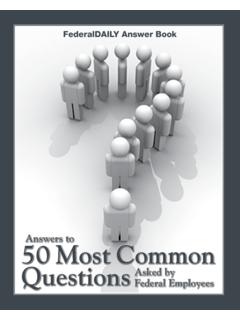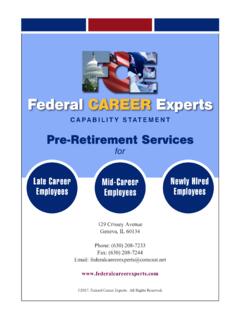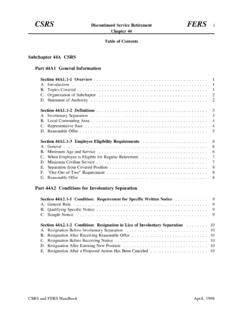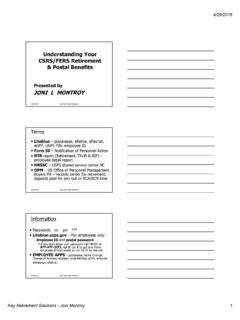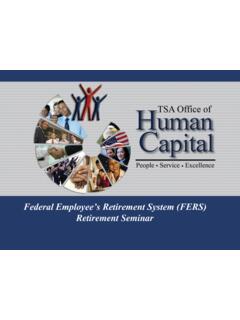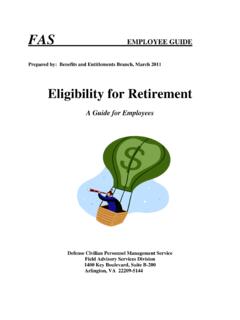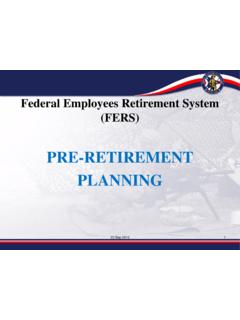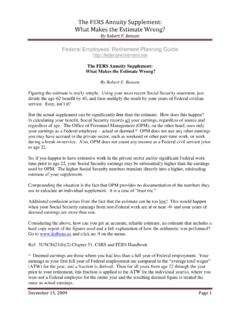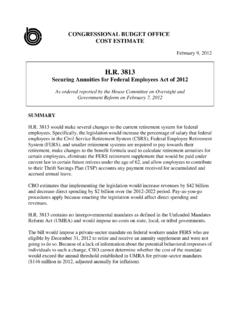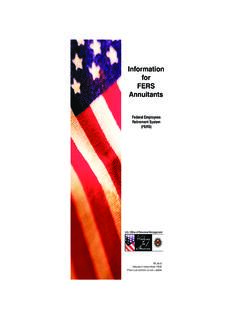Transcription of Retirement YourFERS - 1105 Media
1 fers RetirementYour1 Your fers RetirementHow to Prepare For It, How to Enjoy ItBy Edward A. ZurndorferABOUT THE AUTHORE dward A. Zurndorfer is a retiree of the federal government and is currently the owner of EZ Accounting and Financial Services, an accounting and financial service firm in Silver Spring, MD. He is a Certified Financial Planner (CFP), a Chartered Life Underwriter (CLU), Chartered Financial Consultant (ChFC), Registered Health Underwriter (RHU) and Registered Employee Benefits Consultant (REBC). He is also an IRS Enrolled Agent, licensed to represent taxpayers before the IRS. His firm specializes in the areas of individual taxes, tax preparation and consulting, employee benefits consulting in the areas of health and life insurance and Retirement planning.
2 Mr. Zurndorfer writes for Federal Employees News Digest (FEND). He is the author of numerous other 1105 Media Inc. publications. He has written numerous articles in national and local financial journals, including the National Public Accountant, the Maryland Society of Accountants Journal, and the National Society of Enrolled Agents Journal. He is also the moderator of 1105 s popular question-and-answer forum. He conducts Retirement and benefits seminars throughout the country for federal employees, as well as seminars on the Thrift Savings Plan, long-term care insurance, and the government s new flexible spending accounts program. COPYRIGHT NOTICE 2012 All rights reserved. No part of this publication may be reproduced, stored in a retrieval system, transmitted in any form or by any means (electronic, electric, mechanical, photocopying, recording, or otherwise) without the prior permission of the copyright owner.
3 LICENSING INFORMATION To purchase a license authorizing you to distribute this publication, please e-mail We have attempted to compile information that is accurate and current as possible. Federal policies laws, regulations, statistics, and addresses continually change; therefore, no warranties are made as to the accuracy or completeness of the information in this publication. Published by:1105 Media , Inc.,8609 Westwood Center Drive, Suite 500,Vienna, VA 22182 Contact Information:Customer Service: 1-800-989-3363 Fax: 818-487-4550E-mail: in the United States of AmericaYOUR fers REtiREmEnt3 Table of Contents1. Overview of fers and Types of Retirement ..42. Computation of the fers Annuity ..8 fers Regular Formula for Annuity Computation.
4 163. Adjustments to the Basic Annuity ..18 Deposit or Non-deduction Service Adjustment ..19 Redeposit of Refunded Service ..20 Reduction for Survivor Annuity Benefits ..21 Computing Spousal Survivor Annuity Benefits ..21 Computing an Insurable Interest Survivor Annuity ..22 Children Survivor Benefits ..23 Death Benefits Lump-Sum Payment ..24 Crediting Military Service ..244. The Special Retirement Supplement (SRS) Annuity .. 265. Annuity Commencing Dates, Annual Leave, Lump-Sum Payments and COLAs ..276. The Thrift Savings Plan (TSP) ..287. Insurance Benefits During Retirement ..33 Health Insurance ..33 Life Insurance ..35 FEGLI Beneficiary ..38 Dental and Vision Insurance ..38 Long-Term Care (LTC) Insurance.
5 398. Final Steps for Retirement ..40 Appendix ..43 YOUR fers REtiREmEnt41. Overview of fers and Types of RetirementThe Federal Employees Retirement System ( fers ) is the newer of the two Retirement systems that cover many federal and Postal Service (USPS) employees. Most of these employees began working for the federal government or USPS after Jan. 1, 1984. Some employees covered by the Civil Service Retirement System (CSRS), the older of the two Retirement systems, voluntarily elected to transfer to fers during one of the fers open seasons in 1987 and is categorized as a federal government-sponsored defined benefit Retirement plan. As such, an employee who retires under fers will never outlive his or her fers basic annuity.
6 And if the annuitant has elected a survivor annuity, the survivor annuitant will never outlive the survivor portion of the annuity. On Oct. 28, 2009, the National Defense Authorization Act (NDAA) was passed into law. Among the changes to fers brought about as a result of NDAA s passage that affect current fers employees are:1. the treatment of unused sick leave upon a fers -covered employee s Retirement ;2. changes in the calculation of the high-three average salary for federal employees who work in nonforeign areas such as Alaska and Hawaii; and3. changes to the redeposit rule for those fers employees who left federal service, withdrew their fers contributions, and then subsequently returned to federal service under fers .
7 These changes and how they affect current fers employees are discussed below. fers -covered employees contribute percent of their wages (using after-tax dollars) to the fers Retirement and Disability Fund. The federal government contributes the rest toward the fers annuity on behalf of an employee, and together with earnings on these contributions, a fers -covered employee will be able to retire with a guaranteed income for the rest of his or her life. Each month a fers annuitant receives (as part of the annuity) a portion of what had been contributed. Since these contributions were previously taxed, the annuitant receives these contributions back who were covered by CSRS (with at least five years of service), and who voluntarily transferred to fers during one of the two fers open seasons in 1987 and 1998, will receive two components to their Retirement annuities.
8 One portion comes from CSRS and the other portion from employees also contribute percent of the first $110,100 of their wages (during 2012) to Social Security (the Federal Insurance Contributions Act, or FICA tax). During 2011 and 2012, the employee portion of the FICA tax was reduced to percent. As such, fers employees are eligible to receive Social Security Retirement benefits as early as age 62. They also contribute percent of their wages to Medicare Part A (hospital insurance), and are eligible to receive Medicare Part A benefits starting the month they become age 65. They also have the option of electing Medicare Part B (medical insurance) either at age 65 or when they retire whichever is fers REtiREmEnt5 Finally, a major portion of fers is the Thrift Savings Plan (TSP).
9 During 2012, fers -covered employees may contribute as much as $17,000 of their basic pay to the TSP. In addition, the government automatically contributes 1 percent of an employee s basic pay and up to 4 percent of the employee s basic pay in matching contributions, depending on the amount of the employee s contribution. Those employees who will be at least age 50 as of Dec. 31, 2012, are eligible to contribute during 2012 an additional $5,500 ( catch-up contributions) of their basic pay to the TSP (with no agency matching).Employees need to verify their coverage by checking their Standard Form (SF) 50, which is in their personnel files. Please note Block 30 of SF-50, which is labeled Retirement Plan. Table 1 indicates that a fers -covered employee should have a code K, L, M or N in Block 30.
10 Employees need to verify their codes to make sure that they are in the correct be eligible to retire under fers , an employee: must have at least five years of creditable civilian service, and must be subject to fers on the last day of service used to establish the employee s Retirement 1. Retirement PlansRetirement PlanCivil Service Retirement System Civil Service Retirement System and Social SecuritySocial Security OnlyFederal Employees Retirement SystemCommonly CalledCSRSCSRS Offset FICAFERSSF-50 (Box 30) Code Code 1 or 6 Code C or E Code 2 Code K, L, M, or NYOUR fers REtiREmEnt6 Table 2. Types of fers RetirementsType of Retirement Optional No Age Reduction (MRA + 10) Optional Early Out Involuntary Discontinued ServiceDisability Law Enforcement Officer, Firefighter Air Traffic Controller Deferred MandatoryMinimum Age 62 60 MRA*MRA 50 Any Age50 Any AgeAny Age 50 Any Age 50 Any AgeMRA 62 60 MRA 57 57 56 Minimum Service (Years)5 20 3010 20 2520 2518 months Civilian Service 20 25 20 2510 5 years Civilian Service 20 30 20 20 20 Special Requirements None None None5 Years Civilian Service.

